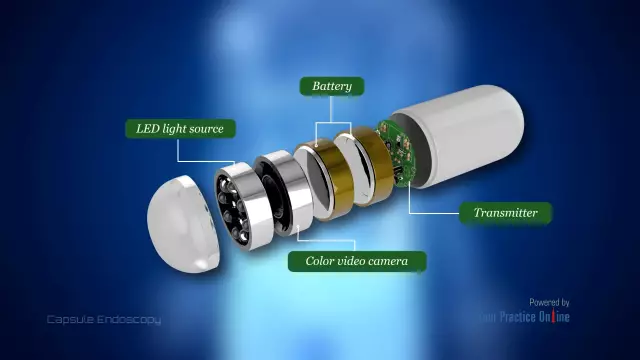- Author Rachel Wainwright [email protected].
- Public 2023-12-15 07:39.
- Last modified 2025-11-02 20:14.
Semprex
Semprex: instructions for use and reviews
- 1. Release form and composition
- 2. Pharmacological properties
- 3. Indications for use
- 4. Contraindications
- 5. Method of application and dosage
- 6. Side effects
- 7. Overdose
- 8. Special instructions
- 9. Application during pregnancy and lactation
- 10. Use in childhood
- 11. In case of impaired renal function
- 12. Drug interactions
- 13. Analogs
- 14. Terms and conditions of storage
- 15. Terms of dispensing from pharmacies
- 16. Reviews
- 17. Price in pharmacies
Latin name: Semprex
ATX code: R06AX18
Active ingredient: acrivastine (Acrivastine)
Producer: SmithKline Beecham Pharmaceuticals (UK)
Description and photo update: 2019-30-12

Semprex is an anti-allergic drug, a blocker of histamine H 1 receptors.
Release form and composition
The drug is available in the form of capsules: hard gelatinous, opaque, white, size No. 3; the body of the capsule has the inscription SEMPREX in red-brown ink, the logo of the company and the black inscription Wellcome are applied to the cap of the capsule; content - white powder (12 pcs. in blisters, 1 blister in a cardboard box and instructions for use of Semprex).
Composition for 1 capsule:
- active substance: acrivastine - 8 mg;
- auxiliary components: sodium starch glycolate, titanium dioxide, dye black iron oxide, lactose monohydrate, gelatin, magnesium stearate, dye iron oxide red.
Pharmacological properties
Pharmacodynamics
Acrivastine is a competitive antagonist of H1-histamine receptors. It has practically no anticholinergic effect. Has a slight ability to cross the blood-brain barrier. The drug causes improvement in conditions that are fully or partially caused by the trigger mechanism for the release of the mediator of allergic reactions - histamine.
After taking Semprex at a dose of 8 mg once, the effect appears during the first 30 minutes. In the first 1.5-2 hours, there is a maximum effect on skin manifestations (such as flushing and rash). The manifestations of allergic rhinitis are reduced within 1 hour after administration. Then the activity of acrivastine gradually decreases, but in general, the antihistamine effect persists for 12 hours after taking the drug.
Pharmacokinetics
Acrivastine is well absorbed in the intestines. Its maximum plasma concentration is 150 ng / ml and is reached approximately 1.5 hours after taking 8 mg of Semprex.
The half-life is approximately 1.5 hours. The drug does not cumulate even after repeated administration for 6 days or more. Almost does not pass through the blood-brain barrier.
About 87% of acrivastine is excreted unchanged in the urine in the first 3 days after taking the capsules. The rest (approximately 13%) is excreted in the feces.
Indications for use
- hay fever (hay fever);
- allergic rhinitis;
- cholinergic urticaria;
- itchy atopic eczema;
- chronic idiopathic urticaria;
- cold urticaria (cold allergy).
Contraindications
- chronic renal failure (serum creatinine more than 150 μmol / l or creatinine clearance less than 50 ml / min);
- period of pregnancy;
- period of breastfeeding;
- children under 12 years of age;
- increased individual sensitivity to acrivastine, capsule auxiliary components or triprolidine.
Semprex, instructions for use: method and dosage
The drug is taken orally with water. The Semprex capsule should be swallowed whole. The drug can be taken at any time, regardless of the diet.
The recommended dose for children over 12 years old and adults is 1 capsule (8 mg) three times a day.
Side effects
Semprex can cause allergic reactions (in particular, skin rashes, and in rare cases - anaphylactic shock). Taking the drug is rarely accompanied by drowsiness. It also does not induce sedative or anticholinergic effects.
Overdose
Overdose cases of acrivastine have not been reported.
After taking Semprex at a dose of up to 1200 mg per day, disorders of the digestive tract (vomiting, nausea, loose stools), as well as weakness and headache, were observed. Sleepiness was mild or absent.
If necessary, the patient's stomach is washed. Further treatment is symptomatic.
special instructions
In elderly patients, it is recommended to monitor renal function during treatment with Semprex.
During the period of therapy, it is advisable to refrain from drinking alcoholic beverages.
Influence on the ability to drive vehicles and complex mechanisms
The drug does not usually cause drowsiness. However, before determining the individual reaction to acrivastine, care should be taken when driving and other vehicles, as well as performing other complex and potentially hazardous work.
Application during pregnancy and lactation
Semprex capsules should not be administered to pregnant and lactating women.
Pediatric use
The drug is contraindicated in children under 12 years of age.
With impaired renal function
Semprex is not used in patients with chronic renal failure (with creatinine clearance less than 50 ml / min).
Drug interactions
Simultaneous intake with alcohol or other drugs that depress the central nervous system can lead to an aggravation of the depressing effect.
Analogs
The analogues of Semprex are Allergodil, Ketotifen, Zyrtec, Claritin, Suprastin, Diazolin, Loratadin, Loratadin-VERTEX, Lorahexal, Tavegil, etc.
Terms and conditions of storage
Store in a dry, dark place and out of reach of children at a temperature not exceeding 30 ° C.
The shelf life of the drug is 5 years.
Terms of dispensing from pharmacies
Available without a prescription.
Reviews about Semprex
According to reviews, Semprex perfectly relieves allergy symptoms. However, it does not cause side effects, addiction or drowsiness.
Price for Semprex in pharmacies
The current price for Semprex is unknown, since today it has been excluded from the State Register of Medicines and is not available in the assortment of pharmacies.

Anna Kozlova Medical journalist About the author
Education: Rostov State Medical University, specialty "General Medicine".
Information about the drug is generalized, provided for informational purposes only and does not replace the official instructions. Self-medication is hazardous to health!






